The northern pike is a captivating fish species, and since I was a child, I have always been fascinated by this apex predator! The pike’s spawning season is an especially fascinating topic, which is why I decided to write this in-depth article about it.
Depending on their range, northern pike typically spawn sometime between March and May, when water temperatures are between 40 and 45F. They can spawn both in open water and under the ice and prefer shallow areas rich in vegetation.
Read on if you want to know everything about the annual pike spawn and whether or not you can fish for them during the spawning season.
PRO TIP: Need to gear up for your next pike adventure? Then check out this quality equipment on Amazon.
It’s very cost-effective, durable, and will land you plenty of trophy pike!
What Time of Year Do Pike Spawn?
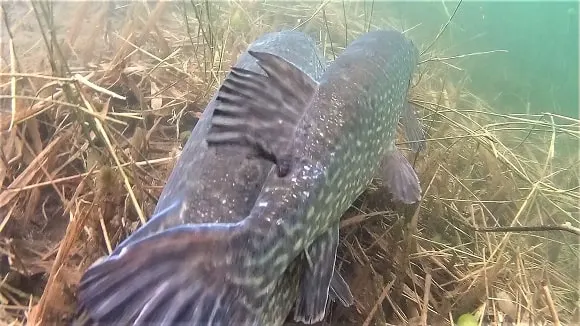
Compared to other freshwater predators, northern pike spawn relatively early in the year, as their breeding season generally takes place between March and mid-May.
Their pre-spawning period will start as soon as the water reaches a temperature of about 40F. Once the temperature climbs to around 45F, the pike will begin the actual act of spawning.
This puts them before most other predators that live in the pike’s habitat (musky, walleye, bass, or perch) when it comes to the time of spawning.
Naturally, the further up north a pike population is found, the later its spawning season will begin.
To give you a better picture of the difference in time of spawning based on the northern pike’s range in North America and Europe, I went ahead and gathered the geographic data:
| Geographical Distribution | Time of Spawning |
| Ontario (Canada) | Mid-May through late May |
| Minnesota (USA) | April through mid-May |
| Michigan | April through mid-May |
| Iowa | Mid-March through mid-April |
| Illinois | March |
| Missouri | March |
| Scandinavia (Europe) | Late-March through mid-April |
| United Kingdom | Mid-March through early April |
What’s especially interesting about pike is that they will sometimes spawn directly after ice-out, in years with particularly long winter seasons.
Spawning pike have been observed in barely open bays of water bodies that still had ice-covered main lake areas.
As the northern pike is abundant in the northern US states and Canada, this is usually more the rule than the exception.
And because the pike’s eggs and fry are adapted to low water temperatures, their survival rate often remains pretty high.
During extreme winters that stretch well into spring, pike can even spawn under the ice. But as the water temperatures under such circumstances tend to be critically low, a much higher mortality rate of the eggs and fry is often the result.
It’s also worth mentioning that, while pike seem to have a reasonably high tolerance toward low water temperatures during their spawning season, they appear to have a very low tolerance toward temperatures that exceed the upper range of 45-50F.
And so, while you can observe or catch post-spawn pike very early during springtime, you will practically never catch a pre-spawn pike in late spring or early summer.
Where Do Pike Spawn?
The northern pike (Esox lucius) is a predatory fish species inhabiting and spawning in lakes, reservoirs, slower-moving rivers, streams, tributaries, and bigger and smaller ponds and dams.
No matter where they live, pike will always try to locate spawning grounds that are shallow and rich in vegetation.
The preferred types of vegetation for spawning pike can include the following:
- weeds and grasses
- reeds
- sunken trees
- brush piles
- underwater rood systems
- deeply overhanging trees and bushes
In lake systems, the fish generally prefer to spawn in tributaries, as they provide better cover and more oxygen for the eggs and fry.
But if the lake they inhabit is a closed system, they make due with bay areas or shallow flats near the shoreline.
In river systems with too strong currents, pike will similarly try to head for slow-moving tributaries if such are present.
They will most likely have more vegetation and a slightly higher temperature than the main river, making them a highly suitable spawning location for river pike.
If there are no tributaries or streams connected to the river, the pike will try to find areas of the primary river system that are as calm and shallow as possible to spawn in.
Shallow backwaters or flooded banks come to mind here and are frequently used spawning locations of northern pike.
They also prefer marches, if such can be found around the river and if the water level is high enough for the pike to reach them.
RELATED ARTICLE: Learn even more fascinating northern pike facts by also reading this article!
What Depth Do Pike Spawn at?
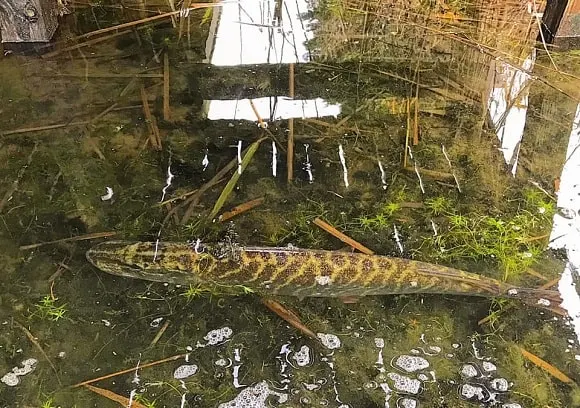
In reservoirs and lakes, the pike’s spawning bays or flats typically have a depth of 1 to 6 feet. In rivers, the fish will seek out shallow streams and tributaries or spawn in shallower backwaters of roughly the same depth with little or no current at all.
If they decided to spawn in flooded bank stretches or marshes, those will commonly have a depth of only a couple of feet, at most.
How Do Pike Spawn?
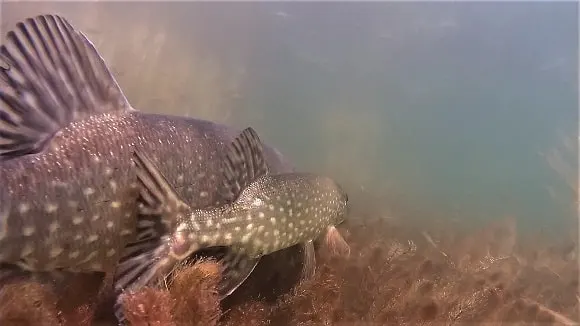
The bigger females will enter the spawning ground just before the mating begins and are usually met by several smaller males that have already been there for quite a while.
After a short while, the female will then start to lay some of its eggs in or close to heavy cover, where they can attach themselves to the vegetation.
This is followed by one of the males releasing some of its milt over the eggs, fertilizing them.
This act of the female’s egg-laying and the male’s milt releasing will be repeated many times over until the female has no more eggs left to lay.
DID YOU KNOW: According to a research paper, the pike’s female to male ratio during the spawn is around 1:4.
Before and during the spawn, both male and female pike can be extremely aggressive, both toward other fish and each other, often resulting in violent fights and painful wounds that can take quite a while to heal.
Of course, it’s most often the smaller and weaker males that will suffer the most injuries, and it is not uncommon for big females to devour the occasional male partner after the act is finished. Nature can be cruel sometimes!
RELATED ARTICLE: Check out this article and find out how to tell a male from a female pike
For How Long Do Pike Spawn?
While the male fish can hang out at their spawning locations for several days or weeks before the actual spawning takes place, the mating act itself will only last a few hours at most once the female pike have joined the waiting males.
After the act, the female’s job is finished, and it will quickly move on and head back to her hunting grounds.
On the other hand, the male pike will remain in the location to wait for the next female that passes by and decides to mate with one of them.
Do Pike Bite During the Spawning Season?
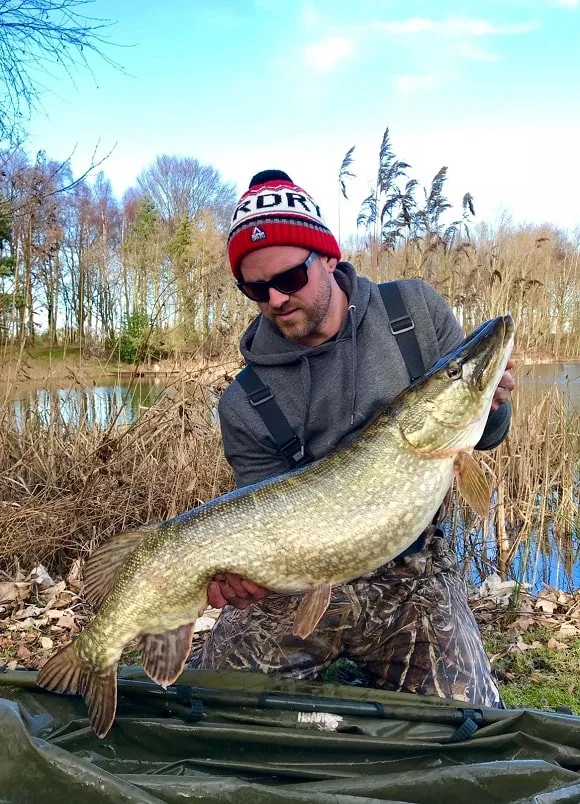
Throughout the winter and the entire pre-spawn period, pike remain active and will hunt and feed continuously until the spawning begins. However, they will generally not eat at all during the spawn, and it can become extremely difficult to catch them.
That also goes for the days leading up to the spawn, by the way!
But if we’re talking pre-spawn pike, I’d say that this is one of the easiest times of year to catch them, as they will both be hungry and increasingly aggressive, attacking pretty much everything that gets too close to them.
I have found that February and March are generally excellent months for targeting big pre-spawn northern pike, both through the ice and in open water.
You can pretty much use anything to target them now, be it spinnerbaits, crankbaits, jerkbaits, spoons, dead or live baits. All of those lures and baits will most likely produce bites!
Should You Fish for Pike During the Spawn?
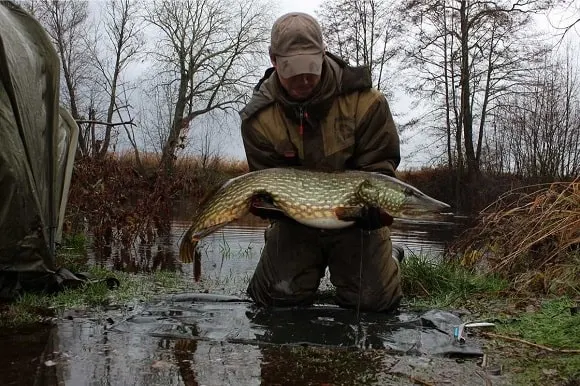
This is a very interesting debate, and the answers mainly depend on where you live and your personal opinion on the matter!
Suppose you live in, e.g., Minnesota or Wisconsin in the United States, or the United Kingdom or Germany over in Europe. In that case, you won’t have to worry about this issue at all, as the pike’s season is closed here between March and May (or even June, in the UK).
On the other hand, if you happen to live in Ontario in Canada, in certain areas in Michigan in the US, or, e.g., in Sweden over in Scandinavia, pike season is open throughout the entire year, without any limitations.
I live in a region that does not have a close season for pike myself, so I have always fished for them throughout the entire spring season.
To me, that’s fairly normal, but to many others, it can be considered odd!
At the end of the day, I think it’s really up to you as the individual angler and what you consider to be okay and fair to the fish!
I, for one, always practice catch and release with all my pike catches and am handle them swiftly and with great care, especially during the pre-spawn period.
That makes it totally okay to me personally, as I know that the bigger females can return to their home and get busy with the spawning, giving life to the next generation of pike in my local waters.
Some will probably not agree with me on that. Others will likely take home pike even during spawning season.
But that’s the way it is. We’ll always have different opinions on certain topics and practice different ways of fishing. That’s totally fine by me!
Just make sure always to follow your local, regional, or national regulations!
How Many Eggs Do Pike Lay?
There is no exact number, but most researchers agree that female pike lay an average of 8,000 to 12,000 eggs per pound. That means that fully matured females with a weight of 20 to 40lb can lay between 200,000 and 400,000 eggs.
That does sound like a lot, but the pike is a species known for its excessive egg production.
As the average mortality rate of juvenile pike is somewhere around 80 to 95%, naturally, the fish’s evolution has enabled them to produce as many eggs as they can carry.
DID YOU KNOW: Cannibalism is pretty common among northern pike. Larvae and juveniles will be eaten by both older and younger fish and other pike larvae.
How Much Weight Do Pike Gain During the Spawning Season?
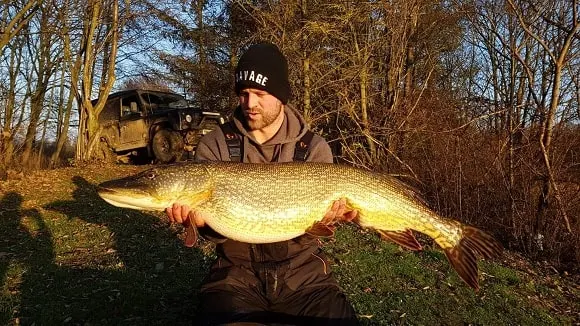
On average, pre-spawn female pike will gain 15 to 20% of their bodyweight, which equals several pounds in mature specimens.
This is a truly fascinating aspect of the pike spawn and the reason why so many trophy anglers, who base their records on weight rather than length, are out for pre-spawn northern pike.
The female’s weight will be at its maximum just before spawning when its gonads (ovaries) enlarge and fill with water.
But how much is an additional 15 to 20% of weight in a large pike?
Here is a list of bodyweight to additional pre-spawn weight list that has the answer:
| Original Weight | Pre-Spawn Weight |
| 10lb | 11.5-12lb |
| 15lb | 17.25-18lb |
| 20lb | 23-24lb |
| 25lb | 28.75-30lb |
| 30lb | 34.5-36lb |
| 35lb | 35.25-42lb |
| 40lb | 46-48lb |
So as you can see, that extra weight can make a lot of difference in an already large northern pike!
Be aware that the above-listed weights are based on pike living in optimal conditions. Naturally, these figures can and will vary quite a bit from waster to water!
Where Do Pike Go After the Spawn?
Once the spawning act is finished and the eggs are laid and fertilized, both the male and the female pike will leave the eggs to themselves and return to their preferred hunting grounds.
These are most often found in deeper waters, even though pike are known also to roam the shallower water areas in search of prey.
When the fry is hatched, it will feed on its yolk-sac until its body and swim bladder are functional enough to start swimming around.
At first, the juvenile fish will keep close to their spawning ground. But the more they grow, the further away they will stray away from their birthplace until they too will be ready for the open water and the great unknown out there in the depths of their lake or river habitat.
Do Pike Spawn More than Once a Year?
Northern pike is a fish species that can and only spawn once every year.
Interestingly though, female pike can carry eggs that have not matured in the gonads until next year’s spawning season and will simply shed them then.
Essential Gear Tips
If you’re looking for solid and reliable pike fishing equipment, these tips might be useful for you.
The following tackle is of top quality and sells at a very reasonable price on Amazon:
Rod: 7′ MH St. Croix Premier Casting Rod
A versatile and beautifully made medium-heavy 7′ baitcasting rod that’s perfect for bigger predators. Casts anything up to 2.5 ounces extremely well. Has an awesome balance, action, and sensitivity.
Reel: Abu Garcia Revo Beast 41 Baitcasting Reel
An affordable, high-performance baitcasting reel with amazing strength. Casts super smoothly and will last you forever! Makes for a great pike combo together with the Ugly Stick!
Mainline: Power Pro Spectra
One of the best braids available today. Zero stretch, great feel, and immense strength make this line the perfect pick for pike in both open and snaggy waters. Put on a 30lb test and you’re good to go.
Related Articles
- Best Time of Day for Pike Fishing (For All Four Seasons)
- Pike vs. Musky (What’s the Difference?)
- What Do Northern Pike Eat?
Featured image courtesy of Mark Barrow (Beneath British Waters)

